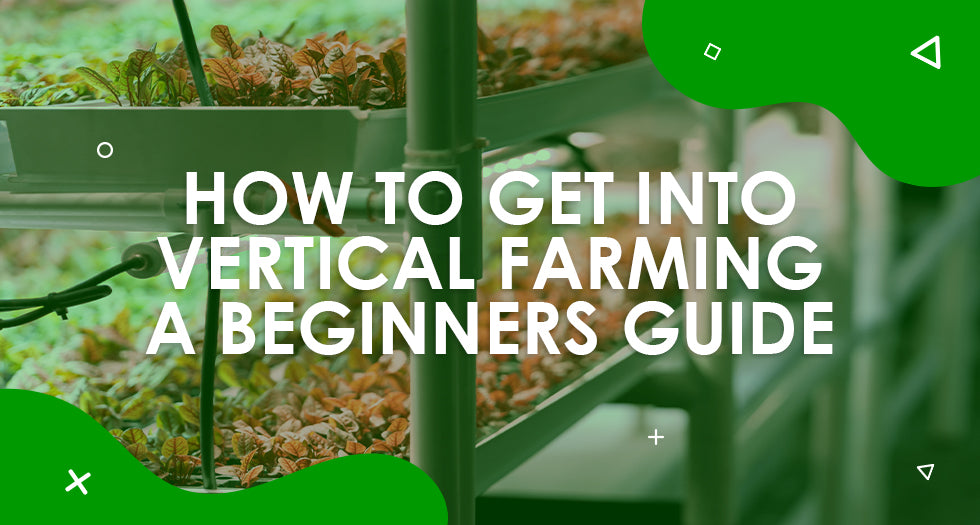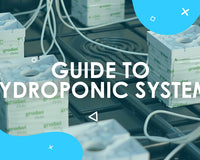Vertical farming is becoming increasingly popular as people look for ways to establish better food security and reduce reliance on shop bought fresh produce. This method is especially popular with those living in urban areas who have very little space to grow crops. Read on to find out how you can get into vertical farming and do your bit for the environment.
What is Vertical Farming?
Vertical farming is the practice of growing crops in vertically stacked layers, rather than on a single surface like an allotment or field. They are usually set up in a greenhouse, indoor grow room or factory. Vertical gardening is also possible in outdoor settings as long as the lighting conditions will support plant growth.
This space-saving farming technique allows growers to produce many more crops per square foot compared to growing on a single surface.
Indoor vertical farms often combine other forms of controlled-environment agriculture, such as hydroponics, aquaponics and aeroponics. These soilless growing techniques are designed to optimise plant growth by delivering the correct levels of nutrients and water to the root zone. Artificial lighting systems are often used to support crops with optimal levels of light when natural lighting conditions are inadequate.
The controlled nature of indoor vertical farms means crops can be grown throughout the year.
How to start vertical farming at home
So, you want to start a vertical farm at home, but how do you go about it? Before you start buying equipment for your new grow structure, there are a few things you need to consider.
- Space: The amount of space you have available will directly impact the size of the structure and types of crops you can grow. Vertical farms at home generally don’t need too much space. However, if you’re planning on setting up a small business growing and selling fresh produce, you will need to ensure you have enough space to make it worthwhile.
- Location: You can build your vertical farm almost anywhere that has enough floor space and height to accommodate the structure. Use a grow tent, disused cupboard or sunny corner of a room. If you’re planning on growing indoors, you’ll need a space that has access to an electricity and water supply for watering, lighting and ventilation. On the other hand, if you intend to grow crops outside, you can place your structure inside a greenhouse, or on a balcony, rooftop or terrace. Just ensure there’s enough protection from the elements and adequate sunlight. You could even build your vertical garden against a wall or fence.
- Crops: What do you want to grow? You can grow almost any type of crop in your vertical farm depending on your preference. Some of the most popular crops for vertical farming include leafy greens (such as lettuce, spinach and kale), herbs (including basil, mint, chives and parsley), microgreens (small versions of a range of produce), strawberries, tomatoes, peppers, cucumbers and other fruit and vegetables. Plants can be grown from scratch with seeds or you can start from seedlings or cuttings.

Mixed Lettuces Pack
|

Classico Italiano Basil
|

Tomato Red Cherry
|
- Structure: There are many types of vertical structures you can use for your farm, such as shelves, racks, towers, barrels, walls, stacked up containers or PVC piping. You can buy ready-made structures or build your own. It’s important to ensure that your structure is sturdy and can support the weight of your plants and growing medium. Propagation tent kits have racking, so these kits offer the ideal set up if you’re just starting out.

Garden HighPro ProBox Propagation Tent
|

Idrolab - Idrorack with Trays
|

Garland Garden Tray
|
- Growing Method: Decide how you want to grow your crops. Trays with soil as a grow medium are an option or you could choose a soilless growing system. Soilless systems include hydroponics (growing plants in nutrient-rich water), aquaponics (growing plants with fish waste as fertiliser), and aeroponics (growing plants with misted nutrients). Each system has its own benefits and drawbacks depending on your budget, amount of space, crop selection, and maintenance requirements. It is possible to buy ready-made kits or you can design your own using a range of components such as drip systems, pumps, tanks, pipes, sprayers, fans, and timers.
- Lighting: If you are planning on growing indoors, you’ll need to factor in a lighting setup. There are many grow lights available to suit a range of applications such as HPS, CDM and LED lighting. If you want to grow a range of crops on different levels then you’ll need to consider each individual plant’s lighting requirements. For this type of set up, lights can be mounted on the underside of the layer above.

Photon LED Board
|

ROOT!T LED Grow Light
|

LUMii EnviroGro T5 Fixture
|
- Grow Media: Consider the grow medium you want to use. If you intend to grow in trays or containers with soil, choosing the right soil type is an important aspect to ensure your crops flourish. Although hydroponics systems can use just water, most growers choose to use a grow media. Aquaponics also require a grow medium. Grow media supports the plant by regulating nutrient intake, water and aeration. There are many options suitable for these systems including coco coir, clay, pebbles and rockwool.
- Plant Nutrients: Nutrients are an important aspect of any home farming set-up. Fertilisers and growth boosters will help your plants to thrive, resulting in higher yields and better tasting produce. The type of nutrients you need and frequency of application will depend on the crop. Some plant nutrients can even help to deter pests.
- Pest & Disease Control: Pests and diseases can be a big problem for growers. There are many products available to buy to help combat an invasion. Aphids and spider mites are common pests but can be easily treated if dealt with immediately. If you fear that you have a pest problem first try to identify the culprit then manage with the recommended treatment. Products like Biogreen X-Force are designed to protect plants from disease and pest attacks. Plant washes like Neem Oil help remove pests from the plant.

BioBizz Bio-Grow
|

Idrolab Nutrients Kit
|

Biogreen Garlic
|
Conclusion
Setting up a vertical farm in your home is a great way to enjoy the benefits of fresh, healthy and sustainable food. It also helps to lower your reliance on imported produce, helping to reduce your carbon footprint. It may seem daunting at first but with research, planning, creativity and dedication you can be a successful urban farmer.

SHOP NOW READ MORE






